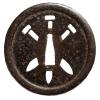Hello everyone,
I joined so I could reply to this posting and clarify a couple of points. I had received Justin's email and I hope answered adequately, but let me reiterate as there is a paucity of information the subject of Nerikawa tsuba in any language. Actually Jim's article on Oyamazumi Jinja collection is the only one I am aware of illustrating a selection of old neri tsuba.
Age dating nerikawa tsuba is very problematic because there is not a documented history or traceable progression of technique or material useage in this group. The only real way to do it is radiocarbon dating. However, we can ask a series of questions and narrow down the possibilities.
From a historical perspective, neritsuba were utilized (we can deduce) quite frequently in antiquity, and their use diminished gradually as economics of production, styles and culture changed through the Muromachi and Momoyama periods. By the Edo period, neri tsuba can no longer be considered a common feature in amongst tosogu, although their production continued in a limited capacity - likely by special order. This leaves us with a paucity of extant examples since neri tsuba being totally organic in composition tend to deteriorate with time, and their popularity was largely confined to the pre-Edo.
Extant Edo neri tsuba tend to date to the late Edo through Meiji periods, and in terms of production were often the domain of lacquerers who used them as an alternate medium to exhibit their skills. They tend to be (from a lacquer perspective) detailed and show a great skill in execution. They are often crisp and retain most of the lacquer which is often in excellent condition and can exhibit a wide range of colours and techniques. Pre Edo neri tsuba exhibit the prevailing aesthetics of the time. Thus they tend to be austere in colour, traditional in form and far more limited in ornamentation... just like the contemporary uchigatana or tachi koshirae they adorned. As with many old lacquers, the colour has begun to change (lets call it patination for lack of a better word). Black lacquer tends to patinate to a taupe or brownish hue. Brown lacquer will patinate to a chocolate or slightly reddish brown hue (this is just a range, so don't hold me to it strictly), etc...
Although this can't be applied as a rule, older neritsuba tend to be composed of 4-6 relatively thin layers (I think I initially wrote 3-5 layers, but that was a long time ago and I should update it). I also have my suspicions that the type of leather used was different in antiquity - ie. leathers resistent to swelling or contraction for servicable tsuba.
The above are tangible factors to consider. There is also a good deal of intangible 'gut feel' to the dating of these tsuba. You have to be exposed to the old and new to develop an eye. Visits to jinja is critical, as is physically handling old pieces, and this is unfortunately not in most people's ability. These things need to 'feel' right for the period and fit into the collective styles and aesthetics for their suggested periods of manufacture.
In the case of the specific tsuba mentioned, the lacquer has begun to change hue, the tsuba is quite robust and generally austere, with minimal lacquer complexity -- small brownish mon are present. The form is a classic style which is not itself particularly indicative of age, but becomes more common in the late Momoyama and Edo periods. It lacks the crispness of Edo work and suggests considerable age. The hitsu ana and plugs are later additions. The tsuba does not feel or look like Edo examples I have handled in the past. It also does not look or feel like Nanbokucho and Muromachi examples I have handled or seen in jinja collections.
SO... I assign a relatively broad date of latest Momoyama to early Edo ca. 17th c..... a defensible position. I hope this helps.
Finally, as a point of clarification, a reference was made to a tachi in my possession dating to the late Heian/ Kamakura period with a lacquered neri tsuba. The piece in question actually has an iron tsuba rusted to the tang.
Best Regards,
Boris Markhasin.


